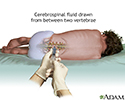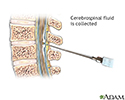CSF analysis
Cerebrospinal fluid analysis
Cerebrospinal fluid (CSF) analysis is a group of laboratory tests that measure chemicals in the cerebrospinal fluid. CSF is a clear fluid that surrounds and protects the brain and spinal cord. The tests may look for proteins, sugar (glucose), and other substances.
How the Test is Performed
A sample of CSF is needed. A lumbar puncture, also called a spinal tap, is the most common way to collect this sample. Less common ways to take a fluid sample include:
- Cisternal puncture
- Removal of CSF from a tube that is already in the CSF, such as a shunt, ventricular drain, or pain pump
- Ventricular puncture
After the sample is taken, it is sent to the laboratory for evaluation.
Your doctor will ask you to lie flat for at least one hour after the lumbar puncture. You may develop a headache after the lumbar puncture. If it happens, fluids and drinking caffeinated beverages such as coffee, tea or soda may help.
How to Prepare for the Test
Your health care provider will tell you how to prepare for lumbar puncture.
Why the Test is Performed
Analysis of CSF can help detect certain conditions and diseases. All of the following can be, but are not always, measured in a sample of CSF:
- Antibodies and DNA of common viruses
- Bacteria (including that which causes syphilis, using a VDRL test)
- Cell count
- Chloride
- Cryptococcal antigen
- Glucose
- Glutamine
- Lactate dehydrogenase
- Oligoclonal banding to look for specific proteins
- Myelin basic protein
- Total protein
- Whether there are cancerous cells present
- Opening pressure
Normal Results
Normal results include:
- Antibodies and DNA of common viruses: None
- Bacteria: No bacteria grows in a lab culture
- Cancerous cells: No cancerous cells present
- Cell count: less than 5 white blood cells (all mononuclear) and 0 red blood cells
- Chloride: 110 to 125 mEq/L (110 to 125 mmol/L)
- Fungus: None
- Glucose: 50 to 80 mg/dL or 2.77 to 4.44 mmol/L (or greater than two-thirds of blood sugar level)
- Glutamine: 6 to 15 mg/dL (410.5 to 1,026 micromol/L)
- Lactate dehydrogenase: less than 40 U/L
- Oligoclonal bands: 0 or 1 bands that are not present in a matched serum sample
- Protein: 15 to 60 mg/dL (0.15 to 0.6 g/L)
- Opening pressure: 90 to 180?mm of water
- Myelin basic protein: Less than 4ng/mL
Normal value ranges may vary slightly among different laboratories. Talk to your provider about the meaning of your specific test results.
The examples above show the common measurements for results for these tests. Some laboratories use different measurements or may test different specimens.
What Abnormal Results Mean
An abnormal CSF analysis result may be due to many different causes, including:
- Cancer
- Encephalitis (such as West Nile and Eastern Equine)
- Hepatic encephalopathy
- Infection
- Inflammation
- Reye syndrome
- Meningitis due to bacteria, fungus, tuberculosis, or a virus
- Multiple sclerosis (MS)
- Alzheimer disease
- Amyotrophic lateral sclerosis (ALS)
- Pseudotumor Cerebrii
- Normal pressure hydrocephalus
References
Euerle BD. Spinal puncture and cerebrospinal fluid examination. In: Roberts JR, Custalow CB, Thomsen TW, eds. Roberts and Hedges' Clinical Procedures in Emergency Medicine and Acute Care. 7th ed. Philadelphia, PA: Elsevier; 2019:chap 60.
Rosenberg GA. Brain edema and disorders of cerebrospinal fluid circulation. In: Jankovic J, Mazziotta JC, Pomeroy SL, Newman NJ, eds. Bradley and Daroff's Neurology in Clinical Practice. 8th ed. Philadelphia, PA: Elsevier; 2022: chap 88.
Somand DM, Meurer WJ. Central nervous system infections. In: Walls RM, Hockberger RS, Gausche-Hill M, eds. Rosen's Emergency Medicine: Concepts and Clinical Practice. 9th ed. Philadelphia, PA: Elsevier; 2018:chap 99.
Review Date: 5/4/2021
Reviewed By: Joseph V. Campellone, MD, Department of Neurology, Cooper Medical School at Rowan University, Camden, NJ. Review provided by VeriMed Healthcare Network. Also reviewed by David Zieve, MD, MHA, Medical Director, Brenda Conaway, Editorial Director, and the A.D.A.M. Editorial team.













